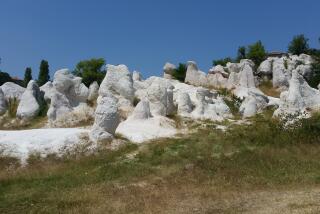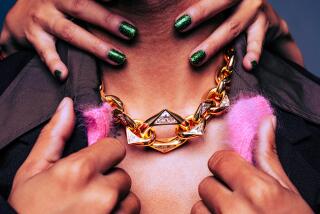A Heavenly Look at Jade
- Share via
When we in the West say someone is “jaded,” there is an implication of over-refinement, world-weariness, of having seen and done it all. Somehow the word has to be connected to the stone, jade, which is currently the subject of an exhaustive exhibit at the Natural History Museum in Exposition Park.
Titled “Stones From Heaven: Ancient Chinese Jade” it’s an encyclopedic exercise blanketing the subject, starting with the profound cultural significance of the stone in China. Reverence for the hard, waxy green stone dates back to the late Neolithic era starting around 4000 BC and is traced to the time of the unification of China in the Han dynasty ending about AD 220. Jade was so significant in Chinese culture that some scholars believe the nation actually had a Jade Age between the Stone and Bronze ages.
There are sections on techniques of cutting and the properties of jade’s mineral sources in nephrite and jadeite. The undertaking was so demanding it required the services of three curators, Adam T. Kessler, Paola Dematte and Anthony R. Kampf. The compendium includes some 400 ritual and decorative objects never before seen in the United States.
The obvious show-stopper on view is a burial suit from the Han dynasty. Fashioned from thousands of small rectangles of jade, it looks rather like a suit of armor. This one is held together with gold wire suggesting that it contained the remains of a person of imperial rank. To modern eyes it has a curious surreal, robot-like aura as if it might get up and lumber toward us, Frankenstein-fashion.
So far, however, none of this hints at the connection between “jade” and “jaded.” Paradoxically, there may be a clue in the very awe the ancient Chinese felt for the stone. For them it had magical and life-giving powers. The burial suits made for the elite were believed to protect their spirits.
Veneration of jade was not confined to its mere appearance. Its tactility was considered beneficial. Ornaments were strung together and hung from the robes of prominent persons. The sound they made swaying together were thought to lend refinement to the wearer. Ground to powder, jade was believed to be a powerful medicine. In short, jade was virtually the source of all good things.
Held in esteem on a par with the West’s enchantment with gold, jade was used to fashion everything from status-enhancing ornaments to objects of mystical significance. Of the former, some of the most impressive are sword fittings. Humans have always lavished great ingenuity and craftsmanship on their weaponry. On the spiritual side are fascinatingly simple, resonant objects called Cong. They look rather like square blocks with a circular pipe sticking out slightly at both ends. The square represents the Earth without, the circle heaven within. They’re lovely pieces of abstract poetry.
As time passed, improved technique and craft refined jade working. During the Warring States period (475-221 BC) bronze or lacquer ware bowls were imitated in jade. By the civilizing Han epoch the slow carving of jade yielded tiny masterworks. A miniature female figure is carved front and back on a flattened tablet. Spun around, she appears to dance like some archaic forerunner of animated films. Free-standing in-the-round figures like that of a tiny owl appear. Dragons once carved flat take on three-dimensions and that otherworldly translucence that makes the material so bewitching.
The technical nitty-gritty that takes up the balance of the exhibit reminds us of the primal, patient labor required to make even such an intrinsically magical material as jade into art. A section on such simple operations as cutting, boring and polishing takes on special attraction. Ways of doing these rudimentary tasks changed slowly over the centuries. Today scholars are increasingly able to use the study of such surface operations to date and authenticate these ancient treasures.
Even more literally down to earth is the study of the material itself. Jade, like all stone, is the product of alluvial time. Most of it is found in riverbeds. Scholar-scientists study not only jade-yielding stone in its natural state but in the form of objects. There they have found that much of the bewitching beauty of these objects comes from time itself.
Discs buried for centuries take on encrusted color changes from deteriorated silk ribbons once wrapped around them. One sort of jade from a particular section in China is valued for its inexplicably smooth glassy surface. Investigators believe the effect comes naturally from a couple of thousand years in the ground. Unearthed, the surface slowly fades to dullness.
There’s a lot of poetry in that too, and in the proposition that being a little jaded may not be a bad thing.
* Natural History Museum of Los Angeles County, 900 Exposition Blvd., Exposition Park, through May 12, closed Mondays, (213) 744-DINO.
More to Read
The biggest entertainment stories
Get our big stories about Hollywood, film, television, music, arts, culture and more right in your inbox as soon as they publish.
You may occasionally receive promotional content from the Los Angeles Times.










